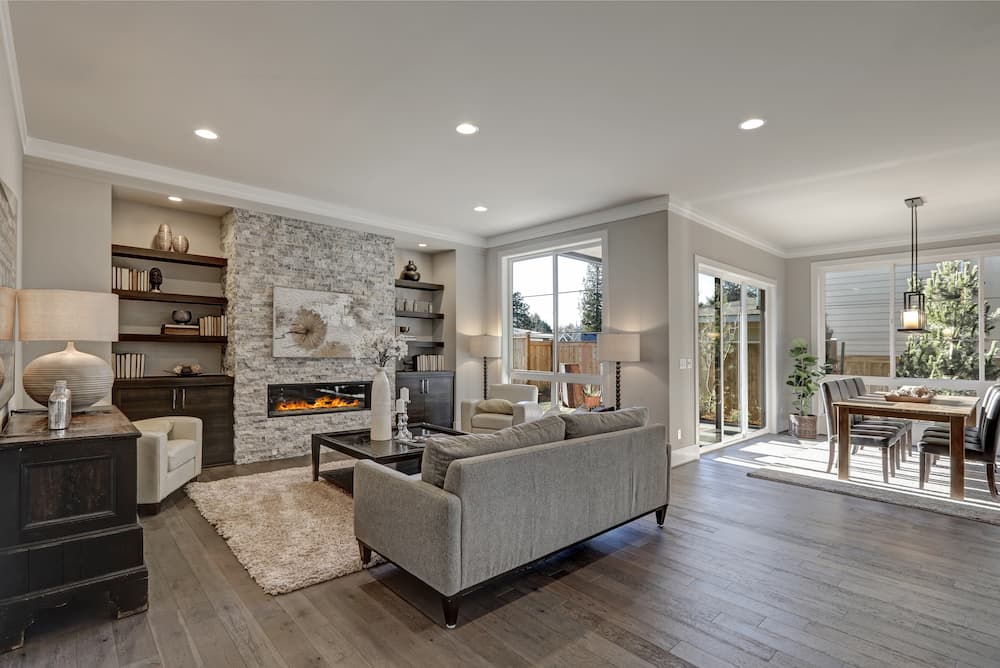Concrete is well known for its durability, but it can also be an aesthetically pleasing material. Decorative concrete—such as stamped, stained, or exposed aggregate—has enhanced the curb appeal of many homes throughout the Metro Detroit area.
Next Level Custom Brick has finished many projects that utilize these materials. This post will explain what decorative concrete is and what you can use it for.
Decorative Concrete
Decorative concrete takes the plain gray of standard concrete and transforms it into something eye-catching and custom. This is typically achieved through stamping and staining—two techniques that dramatically enhance the look and feel of concrete surfaces.
Stamped concrete can mimic the appearance of cobblestone, brick, slate, woodgrain, and more, offering the charm of premium materials without the cost or maintenance. Stained concrete allows for a wide range of rich, vibrant color options. Between the two methods, there are dozens of color combinations and stamp patterns available, making it easy to create a design that’s one-of-a-kind or that seamlessly matches surrounding materials.
These enhancements not only improve aesthetics—they also allow concrete to replicate less durable materials like wood or more expensive ones like stone and brick.
Exposed Aggregate
Exposed aggregate concrete features a decorative, textured finish that reveals the natural stones and pebbles within the mix. This finish is not only beautiful but also highly durable and skid-resistant, making it ideal for flatwork applications like driveways, patios, sidewalks, and pool decks.
To take it a step further, color can be added to the exposed aggregate mix, allowing for even more customization and curb appeal. Additionally, decorative borders can be incorporated along the edges to add definition and visual interest, giving the entire surface more dimension and a clean, finished look.
Stamped Concrete
This technique takes advantage of the fact that concrete is malleable before it sets. Molds are pressed into the wet concrete and left there as it dries to create textures in the final form. Some molds can replicate the textures and shapes of stone, tile, brick, wood, and other materials. A stamped concrete patio is much more attractive than one with plain concrete. The option is also frequently used in walkways, pool decks, and more.
Stained Concrete
Staining concrete gives it new life, eliminating the typical dull, gray appearance. Stains can be used to create intricate patterns that enhance the illusion of materials mimicked by stamping, or they can be applied as solid colors to complement other elements of the design.
There are two main types of concrete stains: acid-based and water-based. Acid stains chemically react with the concrete to produce a marbled, variegated effect. While the color palette is more limited, acid stains are known for their exceptional durability. On the other hand, water-based stains offer a broader range of color options and produce a more uniform finish—perfect for modern, clean designs. Stained concrete floors are one of the most popular uses of this technique, valued for both their style and longevity.
Stamped and stained concrete can be used separately or combined for even greater effect. When paired, they create a surface full of character, dimension, and visual interest. This combination can give your home or outdoor space a truly one-of-a-kind look and feel, blending texture, tone, and pattern to craft something completely unique to your property.
How to Choose the Best Concrete for Your Needs
When planning a new home improvement project, one of the first steps is choosing the type of concrete to use. Here are some tips for deciding between stamped concrete, stained concrete, exposed aggregate—or a combination of these options:
- Aesthetic Preferences: If you care about the visual appeal of the area, choose stamped concrete for a natural material look or stained concrete for unique colors and patterns.
- Application Area: Decorative concrete isn’t ideal for driveways or public sidewalks due to heavy wear and regulations. It works best for private walkways, patios, and porches where you can showcase design without sacrificing durability.
- Maintenance and Durability: Aside from enduring heavy loads, decorative concrete is plenty durable. However, it requires more maintenance to keep it up than regular concrete does.
- Budget: The added visual appeal of stamped and stained concrete and exposed aggregate adds to the cost, making it less ideal when trying to keep costs low.
Upgrade Your Outdoor Spaces with Next Level Custom Brick’s Sidewalk Solutions
If you have an outdoor project planned that will use decorative concrete, let Next Level Custom Brick help make your vision a reality. Contact us today to get an estimate on your project. We have extensive experience working with decorative concrete and can help you find the ideal selection for your aesthetic and functional goals.






